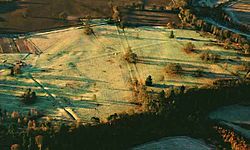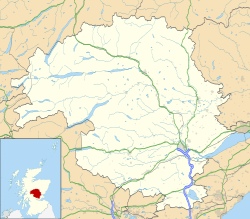Inchtuthil facts for kids
Quick facts for kids Inchtuthil |
|
|---|---|
| Perth and Kinross, Scotland, UK | |

Aerial photograph of the fort site
|
|
|
Location in Perth and Kinross
|
|
| Coordinates | 56°32′28″N 3°25′26″W / 56.541°N 3.424°W |
Inchtuthil is the site of an ancient Roman army base in Scotland. It was a large fortress built on a natural flat area. This area overlooked the north bank of the River Tay. You can find it southwest of Blairgowrie, in Perth and Kinross.
The Romans built this fortress around the year AD 82 or 83. It was meant to be the main base for Governor Gnaeus Julius Agricola's army. He was leading a campaign against the Caledonian tribes in Scotland. Inchtuthil was placed at the start of a main route into the Scottish Highlands. It was home to the Legion XX Valeria Victrix and covered about 21.5 hectares (53 acres).
Building such a big fortress took two or three seasons. The Roman soldiers lived in a temporary camp nearby during the winter. Smaller forts were also built further north and south. These forts were at the mouth of nearby valleys, called glens. They are now known as the Glenblocker forts.
Experts believe that Inchtuthil was the most important military base. It was the only place big enough to start an invasion into the Highlands.
Contents
What did Inchtuthil look like?
Inchtuthil is special because it was never built over later. This means its original layout was still mostly there when Sir Ian Richmond dug it up. He worked on the site between 1952 and 1965. Because of this, we have the only complete plan of a Roman legionary fortress anywhere.
The fortress had strong defenses. These included a wall made of turf with a stone front. There was also a ditch outside and gatehouses on each side. This followed the usual Roman design for their forts.
Who lived at Inchtuthil?
A full Roman legion had about 5,400 soldiers. There would also have been extra specialist troops with them. So, many people lived and worked inside Inchtuthil.
The fortress had many important buildings. There was a hospital (called a valetudinarium) that was 5,000 square meters big. A workshop covered 3,500 square meters. There were also 64 barrack buildings for the soldiers. The wooden walls of these buildings stretched for about 10 kilometers (7 miles).
A main headquarters building was found in the center. This building had a special room called an aedes. This is where the legion's flags and pictures of the emperor were kept. However, this building was smaller than expected for a legionary fortress. It was probably only temporary. The large empty area next to it should have been the commander's house (the Praetorium). But no signs of foundations for such a big building were found.
Why was Inchtuthil abandoned?
Inchtuthil was only used for a short time. The Romans left it around AD 86 or early AD 87. The main reason was likely that another Roman legion, Legio II Adiutrix, was needed elsewhere. This legion was called to Moesia to fight against an invasion by the Dacians in 86 AD.
So, Legion XX Valeria Victrix had to move south to take its place. This meant leaving Inchtuthil. However, newer archaeological findings suggest the fortress might have been used for a bit longer than first thought.
The Inchtuthil hoard of nails
When the site was dug up in the 1950s, something amazing was found. In the summer of 1960, a large pit was discovered. It contained 875,400 complete iron nails. These nails ranged from 2 to 16 inches long. There were also 28 round-shaft nails. All together, the nails weighed 7 tons! Other iron objects, like cartwheel rims, were also found. The total weight of all the iron was ten tonnes.
The pit was very well hidden. The soldiers likely buried the nails and other iron items on purpose. They did this to stop the local tribes from getting them. They buried them before they left and took the fortress apart.
Many of the nails were given to museums as gifts. The rest were sold to the public and other groups. People could buy a 7-10 inch nail for 5 shillings. A boxed set of five nails cost 25 shillings. A company called Colville's helped sort and store the nails. They said all the complete nails were "sorted, gifted, and sold" within three years of being found, around 1963.
These almost 2,000-year-old iron nails have been very useful. Atomic scientists have used them to study how iron rusts. This helps them guess how long barrels of nuclear waste might last.
See also
 In Spanish: Inchtuthil para niños
In Spanish: Inchtuthil para niños



